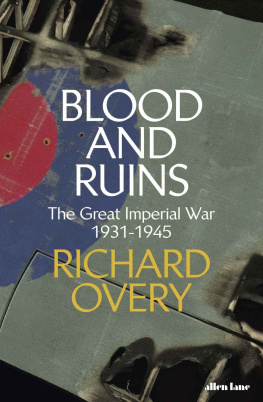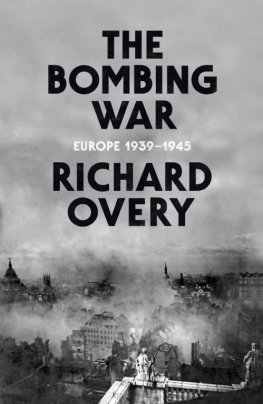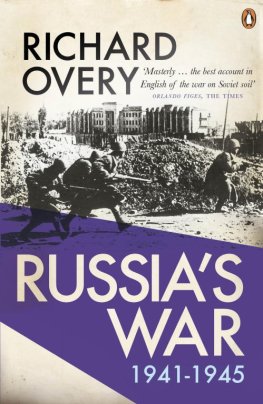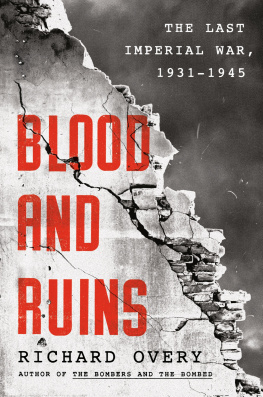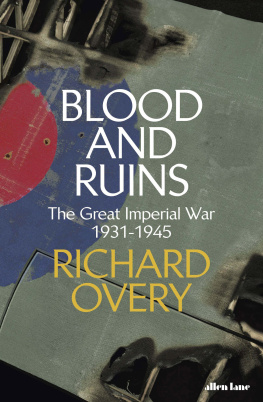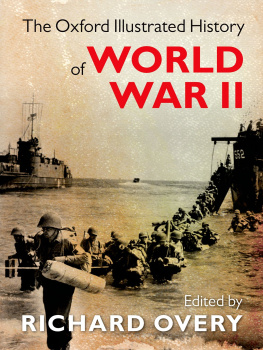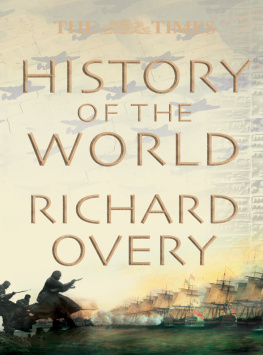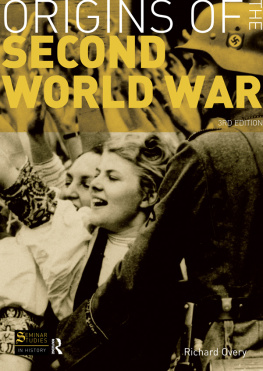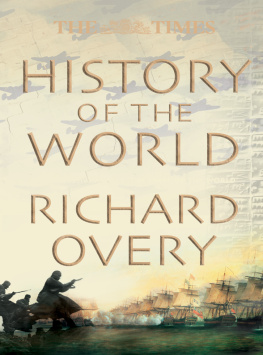
Richard Overy
BLOOD AND RUINS
The Great Imperial War, 19311945

Contents
About the Author
Richard Overy is Honorary Research Professor of History at the University of Exeter and one of Britains most distinguished historians.
His major works include The Dictators, winner of the 2005 Wolfson Prize, Tbe Morbid Age and The Bombing War, which was a finalist for the 2014 Cundhill Prize.
He is a Fellow of the British Academy and a Member of the European Academy of Sciences and Arts.
We have entered the classical age of war on the largest scale, the age of scientific war with popular support there will be wars such as have never yet been on Earth.
Friedrich Nietzsche, 1881
List of Illustrations
Front endpaper: A drawing of the Italian army arriving at the port of Benghazi in the Ottoman Empires province of Cyrenaica during the ItalianTurkish war of 1911. The war ended with Italy in control of the provinces of Cyrenaica and Tripolitania, renamed Libya by the Italian conquerors. Italy was one of eleven European empires. D and S Photography Archives/Alamy
Back endpaper: The United Nations General Assembly in New York in 1971, where delegates representing 132 states stand for a minutes prayer to mark the opening of the assembly session on 21 September. Granger Historical Picture Archive/Alamy
Frontispiece: German foreign minister Joachim von Ribbentrop reads out his statement at the signing of the Three Power Pact between Germany, Italy and Japan in the Reich Chancellery on 27 September 1940. The Pact confirmed the imperial ambitions of the three states in Europe, Africa and Asia, where they intended to found a new geopolitical order. INTERFOTO/Alamy
Prologue: French artillery firing during the Rif War against the Berber insurgency in Morocco, 1925. In one of the major colonial wars of the twentieth century, the tribesmen fought against Spanish and French forces from 1921 to 1927 to retain their independence. Photo 12 Collection/Alamy
Chapter 1: Japanese soldiers shelter behind sandbags in the battle for Shanghai beneath publicity for Coca-Cola. The city was the most cosmopolitan of Chinas leading ports and a major target for the Japanese invaders. It was captured after heavy fighting against Chinese Nationalist troops in November 1937. CPA Media Pte Ltd/Alamy
Chapter 2: A troop of tired German soldiers rest on the wayside somewhere in Soviet Ukraine following the opening of Operation Barbarossa on 22 June 1941. Most German soldiers went on foot or bicycle across the Soviet countryside. World of Triss/Alamy
Chapter 3: The Allied supreme commander in the West, General Dwight D. Eisenhower, walks past an overturned German Panzer VI Tiger tank after the battle at Mortain during the advance across France, August 1944. Pictorial Press Ltd/Alamy
Chapter 4: A column of young Soviet women in Leningrad in 1941, marching to join one of the many popular militia units organized to oppose the fascist enemy immediately after the German invasion. SPUTNIK/Alamy
Chapter 5: British soldiers struggle ashore during Operation Husky, the Allied invasion of Sicily on 12 July 1943. Disembarking from transports in amphibious warfare was challenging. Soldiers had to scramble down netting (visible on the landing ship side) and carry heavy equipment ashore. Shawshots/Alamy
Chapter 6: A woman worker checks the dorsal fins of the US Boeing B-29 Superfortress bomber, mass-produced in the last two years of the war for use in the long-range bombing of Japan. By 1944 women made up to a third of the workforce in US aircraft plants. Granger Historical Picture Archive/Alamy
Chapter 7: A German soldier standing among the decayed corpses of Polish officers and Polish intelligentsia, murdered in April/May 1940 by the NKVD Soviet security service near the forest of Katyn. The mass graves were discovered in April 1943 by the German occupiers and the bodies exhumed. The Soviet regime claimed until 1990 that this was a German atrocity. World History Archive/Alamy
Chapter 8: The Battalion Zoska of the Polish Home Army in 1944, one of the many units that took part in the abortive Warsaw Uprising between August and October 1944, which was repressed with great savagery by the German military and security forces. UtCon Collection/Alamy
Chapter 9: Two young Soviet soldiers during the Battle of Kursk in July 1943, one holding a cross as he waits for combat. Troops everywhere relied on small keepsakes or talismans to cope with the fear of combat. Albatross/Alamy
Chapter 10: A file of young Jewish children arriving at the Chelmno extermination centre in Poland to be murdered in gas vans by carbon monoxide poisoning. The organizers of the Holocaust wanted children killed to ensure that the Jewish race would never revive as a threat to the German empire. Prisma/Schultz Reinhard/Alamy
Chapter 11: Jawaharlal Nehru addressing delegates at the Afro-Asian Bandung Conference in Indonesia in April 1955, the first major international conference of Asian and African countries, many of them recently freed, or about to be freed, from the grip of European and Japanese imperialism. Next to Nehru are Kwame Nkrumah, representing Ghana (Gold Coast), Julius Nyerere (representing Tanganyika) and Gamal Abdel Nasser, leader of an independent Egypt. UtCon Collection/Alamy
List of Tables
Table 4.1 Total Armed Forces of the Major Powers 193945
Table 4.2 Comparative Statistics of German and Soviet Military Deaths 193945
Table 4.3 The Proportion of Women in the Native Workforce 193944
Table 6.1 The Military Output of the Major Warring Powers 193944
Table 6.2 United States Supply of Military Equipment under Lend-Lease 194145
Table 6.3 Japanese Merchant Shipping and Commodity Trade 194145

Preface
In December 1945 the former American secretary of state, Cordell Hull, was awarded the Nobel Prize for peace. Too ill to attend, he wrote a short message endorsing the search for peace after the staggering ordeal of the most widespread and cruel war of all the ages. Hull was well known for his overblown rhetoric, but on this occasion the note he struck seems as pertinent today as it did seventy-five years ago. The era that Hull experienced saw global war on a hitherto unimaginable scale; the many conflicts that are now subsumed under the umbrella title of world war generated suffering, deprivation and death of almost limitless dimensions. There has been no war like it either before or since, not even the Great War. There may be more world wars in the future, capable, as Hull pointed out in 1945, of wiping out our civilization, but they have not happened yet.
A war so widespread and cruel challenges the historian in many ways. With the passage of time since the 1940s it has become progressively more difficult to imagine a world in which more than 100 million men (and a much smaller number of women) donned uniform and went off to fight using weapons whose destructive capability had been honed in the First World War and developed dramatically in the years that followed. It is just as difficult to imagine major states being able to persuade their populations to accept that up to two-thirds of the national product should be devoted to the purposes of war, that hundreds of millions should accept war-induced poverty and hunger, or that peacetime wealth and savings should be taken over and blown away by the insatiable demands of conflict. How hard it is, too, to comprehend the massive scale of deprivation, dispossession and loss suffered through bombing, deportation, requisitioning and theft. Above all, the war challenges our modern sensibilities in trying to grasp how widespread acts of atrocity, terrorism and crime could be committed by hundreds of thousands of people who were in most cases what the historian Christopher Browning has memorably described as ordinary men, neither sadists nor psychopaths. Common though acts of atrocity are every day in the civil wars and insurgencies of the present, the era of the Second World War witnessed a tidal wave of violent coercion, imprisonment, torture, deportation and mass, genocidal killing, carried out by uniformed servicemen, or security and police forces, or partisans and civilian irregulars, both men and women.
Next page
